Germany

88.166.711
habitans
Official data
11.953
Total hate crimes
Motivations with the highest number of hate crimes
 |
Racism and xenophobia |
| 9.108 (76,20%) |
 |
Anti-Semitism |
| 917 (7,67%) |
 |
Attacks against members of other religions |
| 468 (3,92%) |
Chronology of crimes identified by the OSCE
Total 11.953
Civil society data
982
Total hate crimes
Motivations with the highest number of hate crimes
 |
Anti-Semitism |
| 291 (29,28%) |
 |
Crimes against sexual orientation |
| 291 (29,28%) |
 |
Anti-Christianism and other religions |
| 172 (17,52%) |
crimes

29,63% anti-Semitic crimes

29,12% crimes against sexual orientation
Self sourced
Identified mortal victims
Official data
Casualties in Incidents resulting in Deaths and Injuries
civil society data
Mortal victims
Determining the exact motivation for this type of homicide involves a psychological and legal analysis of each case. The collection of data from journalistic and other open sources multiplies the motivations to be taken into account. The present classification is based on the motivations mentioned in the sources consulted.
Figure 21: Map of Germany of identified hate crime mortal victimsby motivation, 2015-June 2020
| • | 4 Victims of racist attacks |
| • | 7 Victims of anti-Christian attacks |
| • | 2 Victims of political intolerance |
| • | 1 Victim of attacks against sexual orientation |
| • | 4 Victims of attacks of multiple motivations |
| 13 men |
| 5 women |

Terrorist attacks
36 fatalities
| • | Jihadist-inspired attacks 26 mortal victims
|
| • | Attacks inspired by right-wing extremism 10 mortal victims
|
Figure 22: Germany’s map of terrorism mortal victims by motivation, 2015-June 2020
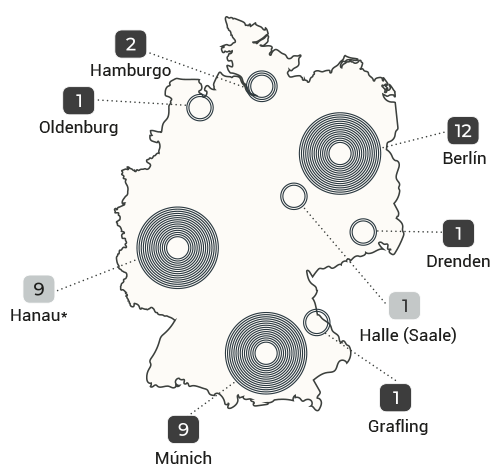
Jihadist-inspired attacks
Attacks inspired by right-wing extremism
| Year | Total |
|---|---|
| 2015 | 1 |
| 2016 | 22 |
| 2017 | 2 |
| 2018 | 0 |
| 2019 | 1 |
| 2020 | 10 |
| TOTAL | 36 |
Terrorist crimes, as public crimes that they are, seek publicity and the destabilization of the political and social order in a direct way, generating a wave of enormous social tension and a sense of vulnerability in our democratic environments. They represent intolerance and hatred against the rule of law as a whole and against freedom as a principle of societies.
*The murderer killed 9 people in the street and then murdered his mother before killing himself. The mother’s death does not officially count as a right-wing hate crime.
Official data
Civil society data
Victims of hate crimes
Official data
Civil society data
Figure 23: Map of Germany total mortal victims: identified victims and victims of terrorist attacks
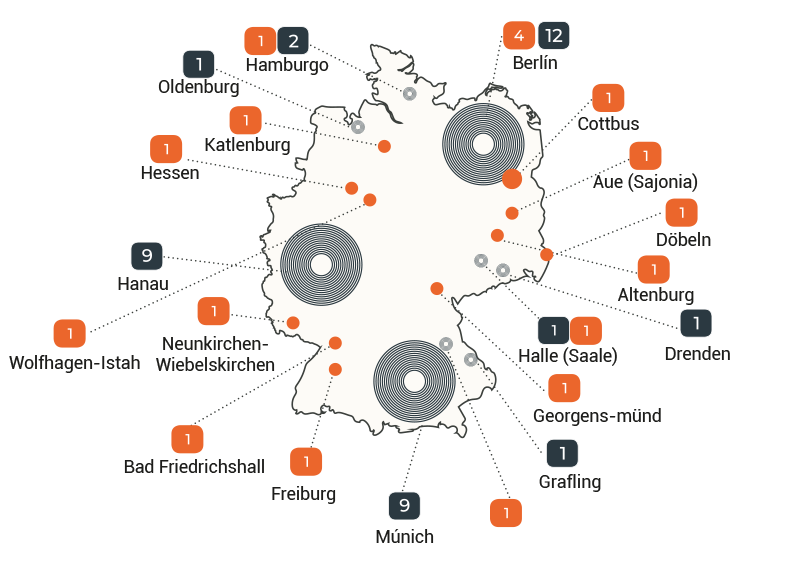
| • | Hate incident mortal victims identified from own sources 18 fatalities
|
| • | Official data: Mortal victimsfrom terrorist attacks 36 fatalities
|
Official data
OSCE. Of the countries analyzed in this study and taking into account only official data provided by the OSCE or police sources, Germany ranks as the country with the highest number of hate crimes. The incidents amount to a total of 11,953 (37.09% of the total number of countries studied), of which 76.20% (9,108) correspond to crimes motivated by racism and xenophobia, standing as the main catalysts of hatred and with data always exceeding a thousand each year.
In 2019, the German Federal Government published “Protests and attacks on refugee accommodation in the fourth quarter of 2019”, a report that responded to the investigation initiated by several MPs. It stated that, as recorded as of January 31, 2020, 65 people were injured in crimes of violence committed in the third quarter of 2019, of whom 8 were minors.
Following racism and xenophobia, anti-Semitism represents the second most frequent motivation with a percentage of 7.67% (917), also presenting a worrying trend since the data have rebounded every year since 2016. Islamophobia also presents increasing data since it goes from 0 crimes during 2015 and 2016 to 268 and 241 during 2017 and 2018.
The rest of motivations present stable and even progressively improving data.
Other official data. However, the figures are clearly higher, because among those that do not pass the OSCE filter, other official data are known that greatly increase the figure. The Federal Criminal Police Office (BKA) concludes that a total of 44,692 politically motivated crimes were committed in the country in 2020, 9% more than in the previous year. Of these, 23,604 were attributed to the extreme right, while 10,971 crimes were attributed to the extreme left. The remainder is divided between Islamism and unattributed ideologies.
Right-wing extremist crimes increased by almost 5.6% over the previous year and accounted for more than half of all politically motivated crimes, the highest level since 2001, when the statistics began.
The Federal Criminal Police Office report includes propaganda offenses, offenses and incitement to xenophobia (accounting for a total of 57.2% of cases), network offenses and violent crimes, of which 3,365 were recorded, up 18.8% from the previous year (1,092 from the far-right and 1,526 from the far-left).
In June 2019, an already convicted neo-Nazi murdered local politician Walter Lübcke for his advocacy of refugee protection, and on October 9th of the same year another far-right extremist tried to break into the synagogue in Halle (east of the country) armed and, failing to succeed, killed two passers-by.
44.692
politically motivated crimes in 2020
 9% higher than the previous year
9% higher than the previous year
23.604
are attributed to the far-right
10.971
are attributed to the far-left
Chronology of crimes reported by OSCE
Total 11.953
Figure 24: Annual development of motivations according to OSCE hate crime data in Germany, 2015-June 2020
- Racism
- Anti-Gypsyism
- Political intolerance
- People with disabilities
- Anti-Christianity
- Antisemitism
- Islamophobia
- Members of other religions
- Crimes of sexual orientation
Figure 25: Map of Germany with total number of hate incidents and motivations with highest percentages

Figure 26: Total crimes in Germany according to OSCE data by motivation
Civil society data
According to data from civil society organizations surveyed by the OSCE, Germany records 994 hate crimes. Of these crimes, anti-Semitic crimes account for the highest number at 291 (29.28%). Homophobic crimes account for a similar percentage (291, 29.28%), which together account for almost 60% of all hate crimes. In third and fourth position and with very similar figures are anti-Christian crimes (172, 17.30%) and Islamophobic crimes (163, 16.40%).
The data for the remaining motivations show very low figures: political intolerance (12, 1.21%), COVID19 discrimination (5, 0.50%).
Beyond the official figures collected and presented annually by the German Ministry of the Interior in its report Politisch motivierte Kriminalität (Politically Motivated Criminality), there is no timely civil society-coordinated recording of hate crimes in general committed throughout Germany.
However, there is a consensus that the official figures are not consistent with the monitoring by various non-governmental organizations.
There is no independent observatory at the federal level that counts hate crimes against LGTBI people.
The Lesbian and Gay Association in Germany (LSVD), consulted for this research, explains that the main difficulty they encounter in identifying these types of crimes and assaults lies in the fact that the police and the judicial authority are reluctant to recognise a homophobic or transphobic motive or possible motive in the crimes. As a result, they cannot be picked up by the media as such either.
The issue also falls under the responsibility of the individual federal states, which only report the figures to the Ministry of the Interior once a year and this makes national monitoring difficult.
106 fatalities from 1990 to date
Considered by the Federal Government
The LSVD points out that the Berlin police itself informs them that the black figure for such crimes and assaults is 80 to 90 percent. Many cases are either not reported to the police or are not properly recorded as hate crimes but only as ordinary crimes.
In each of the 16 federal states there are non-governmental organizations that keep their own records, mostly based on the press, but there is no centralized entity.
A problem of racism and right-wing extremism that has filtered through to the country’s law enforcement agencies has been reported in Germany by civil society and the press.
Already during the presentation of the Politically Motivated Crime Report 2020, Interior Minister Horst Seehofer acknowledged that right-wing extremism has become the main threat to the country’s security. The concern has been made public after the emergence of several cases of radicalised officers working in the police, the German army and the Federal Office for the Protection of the Constitution.
Over the past three years, since 2018, media reports have revealed a number of cases in which members of German law enforcement agencies participated in chat rooms with Nazi propaganda and hate speech. In the federal state of North Rhine-Westphalia alone, more than 200 suspected cases were reported in December 2020. But there are documented scandals in practically all states: Hessen, Berlin, Bayern, etc.
Police and judicial authorities are reluctant to recognize a homophobic or transphobic motive or possible motive for the crimes.
In 2020 a report to the Ministry of the Interior pointed to 319 cases of both police and army personnel having participated in chat rooms with hate speech and Nazi propaganda. These facts have caused the suspension of those involved and an investigation among members of the local police, 58 investigations among the federal police and 1064 among members of the army.
The head of the Ministry of the Interior denies that there is a structural problem and assures that these are isolated cases, and so a detailed study of the incidence of this phenomenon in the security forces has not been carried out.
According to a report from the Ministry of Interior, in 2020, 319 local police officers, 58 federal police officersand 1,064 military personnel partipated in hate chats.
Germany has no centralised data. Only 8 of the 16 Länder monitor hate crimes.
Table 14: Annual evolution of hate crimes in Germany by type of motivation, 2015-June 2020
* Data from the first 6 months of 2020
| GERMANY | TOTAL | Total (%) | 2015 | 2016 | 2017 | 2018 | 2019 | 2020* |
|---|---|---|---|---|---|---|---|---|
| Anti-Semitism | 291 | 29,28% | 134 | 89 | 22 | 23 | 23 | -- |
| Crimes against sexual orientation | 291 | 29,28% | 198 | 36 | 22 | 33 | -- | 2 |
| Anti-Christianism and other religions | 172 | 17,30% | 26 | 39 | 27 | 57 | 12 | 11 |
| Islamophobia | 163 | 16,40% | 5 | 7 | 81 | 68 | 2 | -- |
| Racism and xenophobia | 60 | 6,04% | 15 | 5 | 10 | 29 | 1 | -- |
| Political intolerance | 12 | 1,21% | 1 | 4 | 2 | -- | 4 | 1 |
| Covid-19 discrimination | 12 | 1,21% | 1 | 4 | 2 | -- | 4 | 1 |
| TOTAL | 994 | -- | 379 | 180 | 164 | 210 | 42 | 19 |
Figure 27: Annual incidents in Germany by type of motivation. Civil Society Data
| TOTAL 994 | 2015 | 2016 | 2017 | 2018 | 2019 | 2020 | |
|---|---|---|---|---|---|---|---|
 | Anti-Semitism | ||||||
| 219 (29,28%) | 134 | 89 | 22 | 23 | 23 | ||
 | Crimes against sexual orientation | ||||||
| 219 (29,28%) | 198 | 36 | 22 | 33 | 2 | ||
 | Attacks against members of other religions | ||||||
| 172 (17,52%) | 26 | 39 | 27 | 57 | 12 | 11 | |
 | Islamophobia | ||||||
| 163 (16,40%) | 5 | 7 | 81 | 68 | 2 | ||
 | Racism and xenophobia | ||||||
| 60 (6,04%) | 15 | 5 | 10 | 29 | 1 | ||
 | Political intolerance | ||||||
| 12 (1,21%) | 1 | 4 | 2 | 4 | |||
 | Covid-19 discrimination | ||||||
| 5 (0,51%) | 5 |
Figure 27: Annual incidents in Germany by type of motivation. Civil Society Data
| TOTAL 994 | 2015 | 2016 | 2017 | 2018 | 2019 | 2020 | |
|---|---|---|---|---|---|---|---|
 | Anti-Semitism 219 (29,28%) | 134 | 89 | 22 | 23 | 23 | |
 | Crimes against sexual orientation 219 (29,28%) | 198 | 36 | 22 | 33 | 2 |
|
 | Attacks against members of other religions 172 (17,52%) | 26 | 39 | 27 | 57 | 12 | 11 |
 | Islamophobia 163 (16,40%) | 5 | 7 | 81 | 68 | 2 | |
 | Racism and xenophobia 60 (6,04%) | 15 | 5 | 10 | 29 | 1 | |
 | Political intolerance 12 (1,21%) | 1 | 4 | 2 | 4 | ||
 | Covid-19 discrimination 5 (0,51%) | 5 |
Cases
JIHADIST-INSPIRED TERRORIST ATTACK AGAINST A CHRISTMAS MARKET. Anis Amri, a Tunisian man influenced by the Islamic State, drove a HGV into a Berlin Christmas market, killing 12 people and injuring 55. The attack was claimed on 17 August 2017 by the terrorist group and Amri was killed three days later in Milan after being caught by police.
The attack took place in a context in which the Islamic State was in a position of strength in Syrian-Iraqi territory, with a full-fledged propaganda apparatus and without suffering excessive external pressure that could diminish its ability to radicalise. The story of Anis Amri’s radicalisation is not unlike that of many other terrorists. The young man had come to Europe illegally from Tunisia. After committing numerous crimes, including setting fire to the reception centre where he lived, as well as theft, threats and assault, he was convicted and served four years in a prison in Palermo. It was in prison that police sources say Amri came into contact with individuals who held radical Islamist beliefs and who influenced him in his own trial.
The Italian newspaper Il Fatto Quotidiano, citing a report by the Department for Penitentiary Institutions, reported an incident in which Amri threatened to kill another inmate with Catholic beliefs, claiming that he was going to cut his head off. Anis Amri did not belong to a large cell and did not elaborate a complex attack, but with the jihadist hate speech assimilated and internalised he was able to leave a trail of death and terror in his wake.
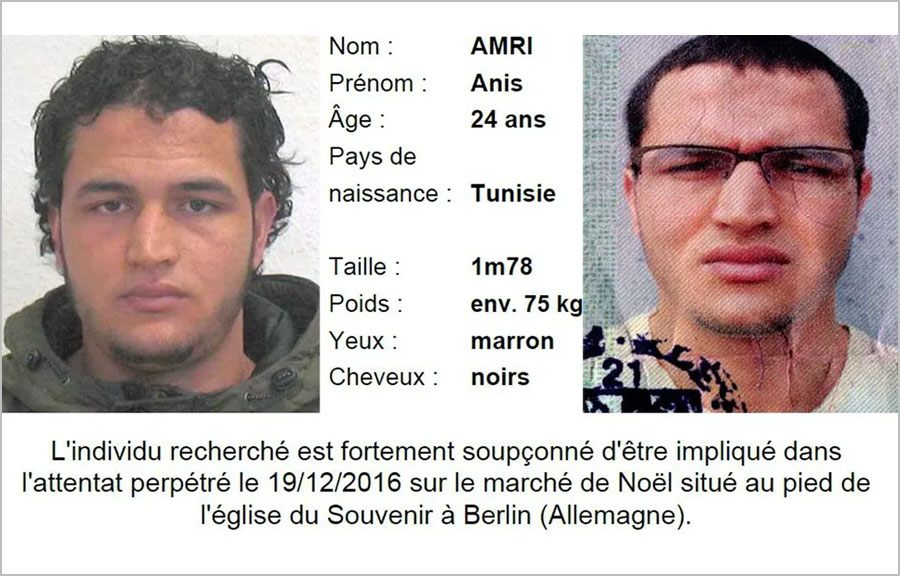
The wanted poster for Anis Amri. BKA.de / German police


Breitscheidplatz, Berlín
![]()
Fuente: Observatory on Intolerance and Discrimination against Christians in Europe, BBC News![]()
Abdesslam / France-Presse
Amri’s case is an example of the gradual radicalisation of a boy who had no interest in religion and a long criminal record, turning him into someone willing to carry out violent acts in the name of a fanatical and rigorist vision of Islam. The Italian anti-terrorist services noted that he was a dangerous subject, with a threatening behaviour towards prison officers and that he acted as a leader of other Islamists.
The process Amri underwent was reinforced during his stay in Germany. Living with individuals who professed a radical ideology and frequenting other environments and mosques where Salafist speeches were made, underpinned the jihadist ideological consolidation. Among the factors that promote radicalisation at the micro level, the factors of identity and belonging to a group are a powerful cognitive cohesive element that reinforces the belief embraced by the individual. In Amri’s case this is further reinforced by a network of contacts and friendships that further accelerate the process. Amri attended the Dortmund madrasa, a Koranic school run by Boban Simeonovic, who was a member of Abu Walaa’s German cell. A German police informant who was undercover in the cell confirmed that Boban went on to mentor Amri and that although they discussed in the group the possibility of committing an attack, Amri’s desire was to join Islamic State in Syria.
Radicalisation processes can present a blind spot of uncertainty, as human beings are complex and do not respond in the same way to similar stimuli and conditioning factors. The same enablers that may lead to radicalisation for one subject may not be sufficient for another. However, the presence of one or more radicalising agents can act as a catalyst. In this way, hate speech is progressively reasoned, justified and legitimised with a series of emotional, religious and other arguments that gradually take hold in the subject. In addition, this mentor-mentee relationship tends to be reinforced by the emergence of a friendship, whether natural or artificial (on the part of the mentor).

Atentados yihadista contra un mercado navideño en Berlín en 2016, en el que doce personas fueron asesinadas y unas setenta resultaron heridas
Amri had found a sense of belonging, a vital purpose and was willing to die and kill for an ideology. In the video he left behind in which he pledged allegiance to the leader of the Islamic State, Amri made all his tenets clear. The rhetoric employed shows total radicalisation, dehumanisation of the enemy justifying his elimination, a sense of grievance, victimisation of the Islamic community and a proselytising call for his “brothers” to carry out more attacks.
“To those infidels who bomb Muslims every day, I swear we will hunt them down and kill them like pigs for what they do to these Muslims… And I call on my Muslim brothers and sisters all over the world to participate in jihad, and fight for the dominance of this religion, as much as each of you can…. And if you live in Europe, then fight those pigs, each with your own skills,” he said.
RIGHT-WING EXTREMIST-INSPIRED ATTACK IN HANAH KILLS TEN PEOPLE IN MARCH 2020. The double attack that shook the country was committed by a right-wing extremist individual who targeted premises frequented especially by the Kurdish community. The attacker first shot up a shisha bar and then moved on to a different location in a different part of the city. The two attacks resulted in 10 mortal victims and 5 wounded. The terrorist was found dead in his home next to the body of his mother, whom he allegedly shot before committing suicide.
The ideology of Tobias R. – 43 years old – was set out in a manifesto that he left written before committing the attack. The 24-page manifesto reflects his fixation on conspiracy theories and his deep hatred of foreigners and non-Caucasians. His writing was a call for supremacism: he spoke of the superiority of certain races and the need to exterminate countries in North Africa, the Middle East and Central Asia.

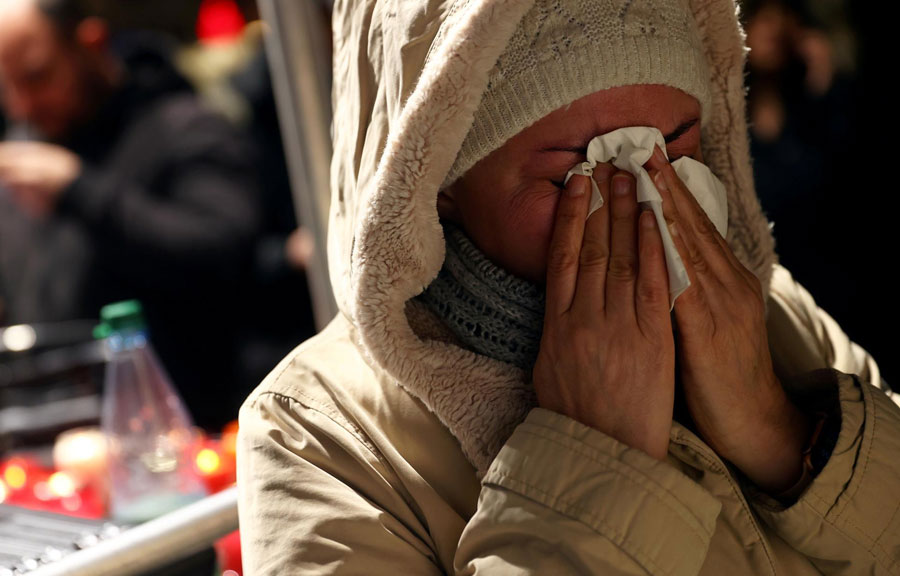
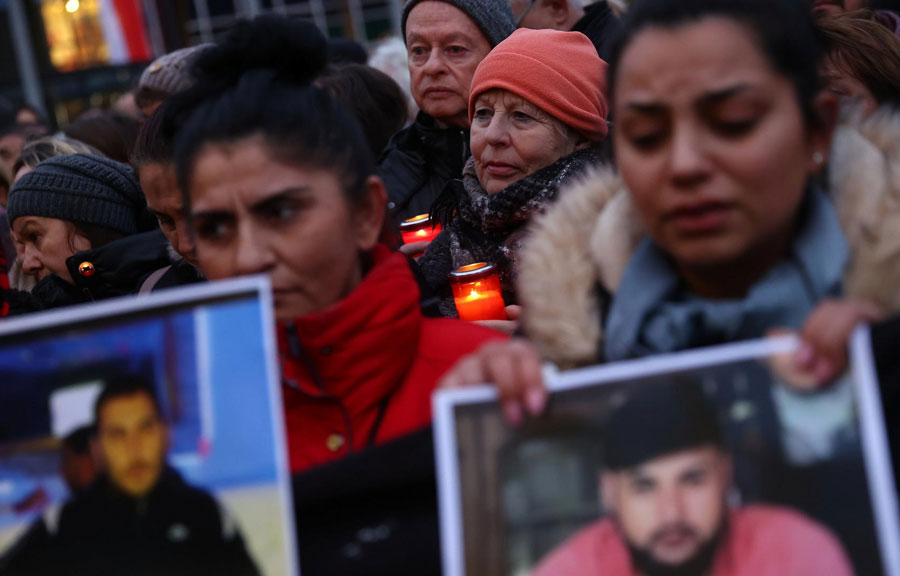
Pictures of the right-wing extremist attack in the German city of Hanau and the protest rallies
ASSAULT ON LGTBI ACTIVIST MARCEL ROHRLACK. In July 2015, Marcel Rohrlack was returning home from the Gay Pride march, dressed in high heels and a dress, when he was assaulted by a group of men.
Mario K was brutally murdered inside his flat by two young men aged 19 and 23 who claimed they wanted to punish him for having offered them money in exchange for sex. During the trial, a homophobic motivation and a justification in line with Social Darwinism common in the far-right narrative was revealed.
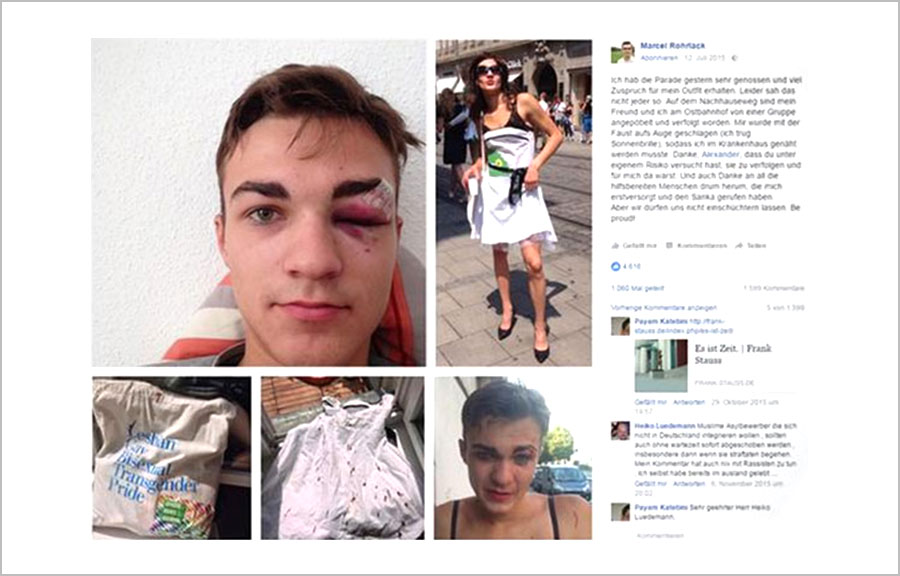
Attack on LGBTI activist Marcel Rohrlack.
ASSAULT ON LGTBI ACTIVIST MARCEL ROHRLACK. In July 2015, Marcel Rohrlack was returning home from the Gay Pride march, dressed in high heels and a dress, when he was assaulted by a group of men.

Attack on LGBTI activist Marcel Rohrlack.
Mario K was brutally murdered inside his flat by two young men aged 19 and 23 who claimed they wanted to punish him for having offered them money in exchange for sex. During the trial, a homophobic motivation and a justification in line with Social Darwinism common in the far-right narrative was revealed.
![]() 17-04-2018
17-04-2018
![]() Helmholtzplatz, Berlín
Helmholtzplatz, Berlín
![]() Source: Jüdisches Forum, DW
Source: Jüdisches Forum, DW
ANTISEMITIC ATTACK ON A YOUNG MAN WEARING A KIPPAH IN BERLIN. On 17 April 2018, the organisation Jüdischen Forum published a video on its social media channels showing an attack on a young man, Adam, who was wearing a kippah. A group of three people who, according to the victim’s testimony, spoke Arabic, began to insult him and one of them used his belt to attack him. The young man claims that, of the fifty or so people in the street at the time, only one woman confronted the attackers.
MURDERED FOR CONVERTING TO CHRISTIANITY (ALE-699). A woman who had recently converted to Christianity is stabbed to death. German authorities report that the attacker had a criminal record for murder motivated by hatred of Christians.
Late on 22 February 2018, Father Alain-Florent Gandoulou, a chaplain of Congolese origin in West Berlin, was beaten to death by a man in the presbytery.

Shaden Mohamed, a 22-year-old student at the German University in Cairo (GUC), was injured after being run over and abandoned by offenders in Cottbus.
The young woman, who was visiting Germany, died days later in hospital. Two witnesses reported hearing a passenger in the car shouting “Go back to where you came from, then you won’t get run over. Fucking refugees”.
Shaden Mohamed, a 22-year-old student at the German University in Cairo (GUC), was injured after being run over and abandoned by offenders in Cottbus.
The young woman, who was visiting Germany, died days later in hospital. Two witnesses reported hearing a passenger in the car shouting “Go back to where you came from, then you won’t get run over. Fucking refugees”.

NEO-NAZI DEMONSTRATION IN HANNOVER. Around 5,000 people called by the German far-right group Hooligans gegen Salafisten (Hooligans against Salafists) demonstrate in the vicinity of Hannover’s central station. Most were dressed in black, had their heads covered and were neo-fascist hooligan fans of German Bundesliga clubs. German police prevented the demonstrators from crossing paths with radical ultra-left groups who had also come to the city.
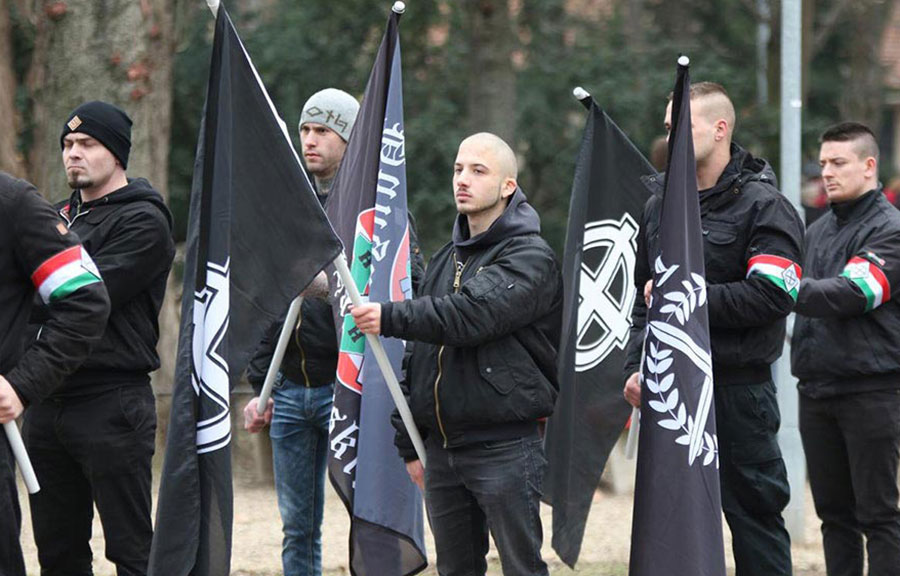
Some 5,000 neo-Nazis take part in a demonstration called by an ultra football group.
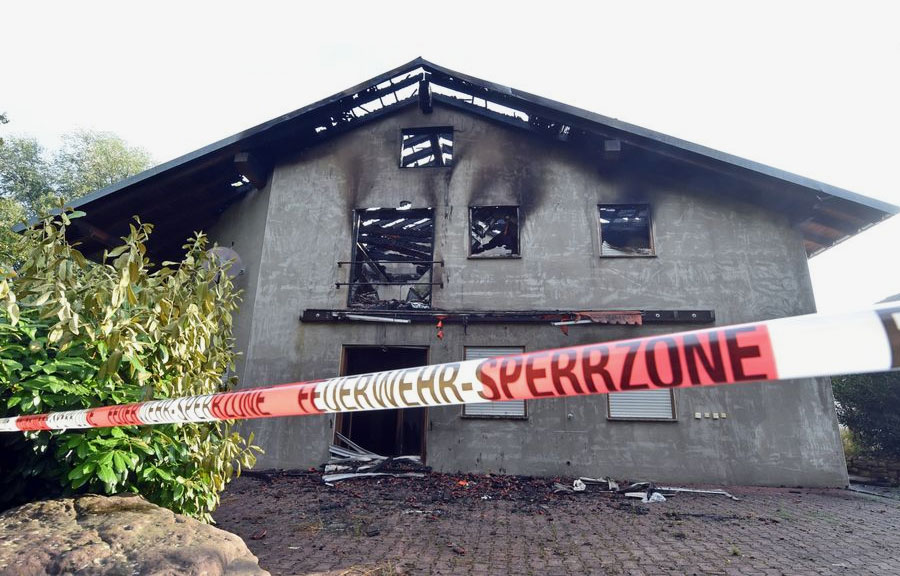
Daño de fuego en Remchingen
SERIES OF ATTACKS ON REFUGEE HOMES IN GERMANY. The series of attacks on refugee homes in Germany between 2014 and July 2015 was very intense; eight cases were recorded. Most of them were arson attacks, but the centres have also experienced shootings, desecration with pigs’ heads and graffiti, which have left serious material damage.
SERIES OF ATTACKS ON REFUGEE HOMES IN GERMANY. The series of attacks on refugee homes in Germany between 2014 and July 2015 was very intense; eight cases were recorded. Most of them were arson attacks, but the centres have also experienced shootings, desecration with pigs’ heads and graffiti, which have left serious material damage.

Daño de fuego en Remchingen
In the first six months of 2018, Germany has recorded almost one xenophobic attack per day against refugee centres. This included arson attacks on centres occupied by minors.
The number of attacks on refugee accommodation has been steadily rising in 2015 and 2016, since Chancellor Angela Merkel’s decision to open the doors to almost one million refugees from the Near East and Africa.
Many arson attacks were framed by police as the actions of far-right groups.
In 2016, the number of attacks against refugees published by the Ministry of the Interior stood at around 3,500, leaving 300 injured; in 2017 there were 2,219 attacks against refugees and their shelters, in 2018 there were 1,948. In the first half of 2019 at least 102 people were injured in 609 attacks targeting refugee centres or relief organisations.
These attacks included verbal abuse, physical violence and arson, according to the Ministry of the Interior.

View of the facade of a refugee centre in Böhlen that was shot at.
Philipp W., 38 YEARS OLD. On the evening of April 17, 2018, an arson fire broke out in a baby carriage on the wooden staircase of a residential building in Neunkirchen-Wiebelskirchen (Saarland). The flames quickly spread throughout the house. The town council had rented parts of the building to house refugees, many Syrians, including some children. Firefighters saved eleven people, some of whom suffered severe smoke poisoning. For 38-year-old attic resident Philipp W., however, help from the emergency services came too late.
Ruth K., 85 YEARS OLD. She was the victim of arson that was not actually directed at her. The police determined that the fire was caused by a neighbour who wanted to harm an asylum seeker living in the house. The culprit gave the police false information and filed a large number of complaints against the refugee. The prosecutor identified “hatred of foreigners” as the motivation.



